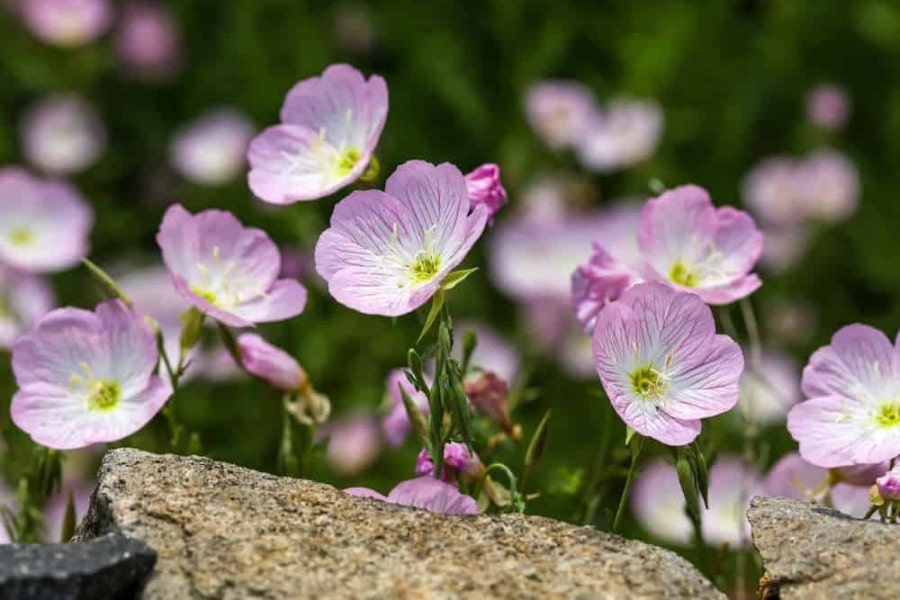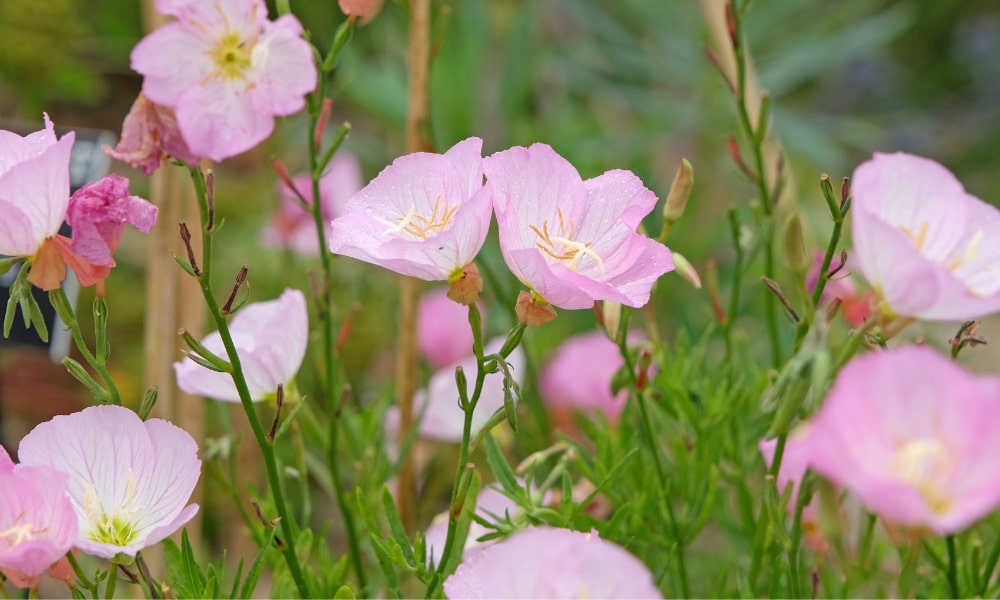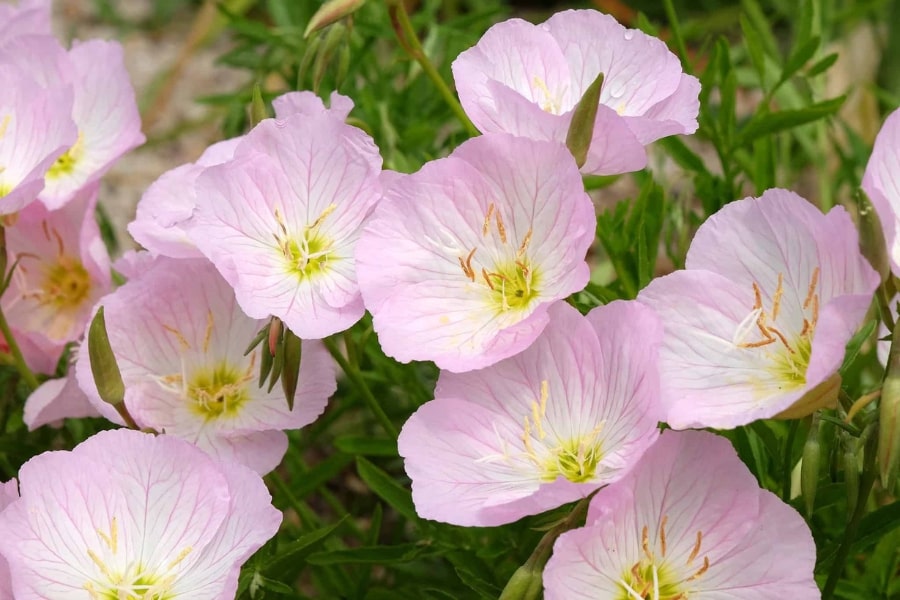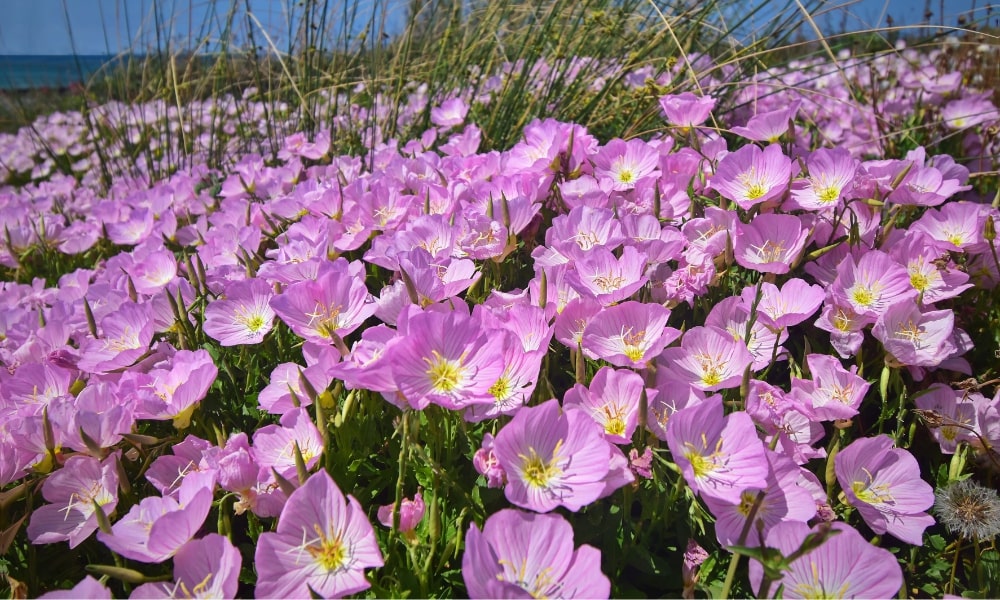Oenothera, also known as Evening Primrose, is a genus of flowering plants from the Onagraceae family. This perennial is known for its stunning, cup-shaped flowers that often bloom in the evening, giving the plant its unique name. Evening Primrose can grow up to 3 feet tall and spread about 2 feet wide. It thrives in well-draining soil and full sun, making it a resilient choice for various garden settings. In addition to its beauty, some species of Oenothera are valued for their medicinal properties, particularly their oil-rich seeds. Evening Primrose is completely unrelated to Common Primrose (Primula vulgaris) even though it shares the Primrose name.

Our Selection of Oenothera
Oenothera siskiyou, the pale-pink evening blooming variety, is the most common species found in Upstate South Carolina. It is super drought tolerant, so perfect at locations that have no irrigation. At Martin Garden Center, we have grown this variety which is wonderful, and a yellow blooming variety that was not, and we shall not repeat that mistake. Luckily, our vendors supply Oenothera in 4″ containers sometime in the Summer to early Fall, when the plant is set to bloom. We do not have a year-round stocking of this plant. So, buy it in the Summer when it is available, or wait another year to see these gorgeous pink evening flowers.
Growing and Caring for Oenothera
Oenothera thrives in full sun but can tolerate some shade. If planting in a hot climate, provide some afternoon shade to protect the plant from intense sun. This plant thrives in sandy or loamy soils, but it can adapt to various soil types. Ensure that the soil pH is slightly acidic to neutral. Proper drainage is crucial to prevent waterlogged conditions, which can lead to root rot. Planting in an area with good air circulation can also help prevent fungal diseases.
While Oenothera is drought-tolerant once established, regular watering is essential during the initial stages of growth. Water deeply but infrequently to encourage the development of a robust root system. Once the plants are established, reduce watering frequency, allowing the soil to dry out between waterings. Avoid overhead watering to prevent fungal issues, and water at the base of the plant to keep the foliage dry.
Pruning helps maintain a tidy appearance and encourages continuous blooming. Deadheading spent flowers can prolong the blooming period and prevent self-seeding, especially in situations where you want to control the plant’s spread. Regularly cut back the stems after flowering to promote bushier growth and more blooms.
Oenothera generally doesn’t require heavy fertilization, but incorporating a balanced, slow-release fertilizer in the spring can promote healthier growth and more abundant flowering. Avoid excessive nitrogen, as this can lead to lush foliage at the expense of flowers. Always follow the specific fertilizer recommendations for the particular species or cultivar you are growing.
Oenothera is also relatively resistant to pests and diseases, but monitoring for common issues such as aphids or powdery mildew is essential. Insecticidal soap or neem oil can help control pests, while proper spacing and good air circulation can mitigate the risk of fungal diseases. Regular inspection and prompt action at the first sign of trouble can help keep your Oenothera plants healthy.

Leaves and Flowers
Oenothera has elongated, lance-shaped leaves that grow in a rosette at the base of the plant. The leaves are typically dark green and have a slightly fuzzy texture. The leaves of some species of Oenothera have somewhat serrated edges and may be covered in fine hairs.
The flowers of Oenothera are the plant’s most distinctive feature. The flowers range from yellow to white, pink, and red. The flowers bloom in the evening and have a delicate, papery texture. The petals of the flowers are arranged in a cross shape and have a slightly crinkled appearance.

Uses in the Garden
The plant’s bright and cheerful flowers, which come in shades of yellow, pink, or white, create eye-catching displays that enliven flower beds, borders, and other garden areas. Whether planted as standalone specimens or massed together in clusters, Oenothera’s blossoms bring a touch of radiance and beauty to outdoor spaces, especially during the evening hours when they tend to open.
Oenothera is also vital in supporting pollinators; its blooms open at the end of the hottest days and in the hottest months when other flower sources are no longer available, thus providing nectar at a time when most flower sources are drying up. Moreover, some Oenothera species are known for their fragrant blooms, adding an extra sensory dimension to the garden experience. As evening descends, the alluring fragrance of Evening Primrose wafts through the air, creating a delightful ambiance that adds to the overall sensory delight of the garden. Because of its ability to withstand drought and its tendency to spread by stolons, this plant is best suited for prairie and meadow gardens, coastal and wildflower gardens, and as a groundcover in poor quality soil areas.

Frequently Asked Questions
Is Evening Primrose Invasive?
Some species of Oenothera, particularly Oenothera biennis (Common Evening Primrose) and Oenothera speciosa (Pink Evening Primrose), can spread aggressively through self-seeding and underground rhizomes. To prevent unwanted spread, deadhead spent flowers before they set seed and plant in contained areas if necessary.
Is Oneothera Deer Resistant?
Yes, Oenothera (Evening Primrose) is generally deer-resistant due to its slightly hairy foliage and sometimes bitter taste, which deer tend to avoid. However, in areas with high deer populations or food shortages, they may still nibble on the plant. If deer are a concern, planting Oenothera alongside strongly scented herbs or using deer repellents can help deter browsing.
